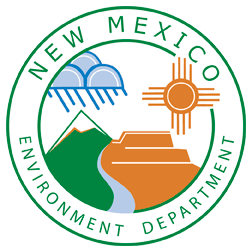Nutrients, such as phosphorus (P) and nitrogen (N), are essential for proper functioning of ecosystems. Rain, overland runoff, groundwater, drainage networks, and industrial and residential waste effluent can all transport nutrients to receiving waterbodies. Once nutrients have been transported into a waterbody they can be taken up by aquatic vegetation and microorganisms, sorb to particles in the water column and/or sediment, or they can be transformed and released as a gas from the waterbody (denitrification).
While a certain amount of nutrients are necessary for a healthy aquatic ecosystem, excess nutrients cause unfavorable conditions. Algae and macrophytes can develop rapidly in response to nutrient enrichment and can interfere with designated uses such as recreation, domestic water supply, or aquatic life. High amounts of algal growth can be esthetically unpleasant and unappealing to swim and wade in, it may impact drinking and irrigation water uses by clogging intakes and producing unpleasant tastes and odors, and cause changes in the fish and invertebrate community and loss of sensitive species. These impacts can range from minor annoyances to serious health concerns (Dodds and Welch, 2000), and can vary by waterbody type and ecoregion. Documented impacts that can be attributed to nutrient impairment include:
- Taste and odor problems in drinking water supplies;
- Increased treatment required for drinking water;
- Human health problems, such as blue baby syndrome and non-Hodgkin lymphoma;
- Adverse ecological effects, such as large diurnal swings in dissolved oxygen (DO) and reduction of habitat utilized by aquatic organisms; and
- Harmful algal blooms that can cause fish kills, and injury to people, pets, wildlife, and livestock.
In a national report to Congress, the U.S. Environmental Protection Agency (US EPA) reported that N and P are among the leading causes of water quality impairment in the U.S. and that 40% of rivers/streams and 51% of lakes/reservoirs in the U.S. are impaired. Thus, the need to accurately monitor and assess nutrient impairments and develop effective total maximum daily loads (TMDLs) for impaired waters is evident. Numeric translators, or threshold values, are necessary in order to accomplish this. To aid in the development of threshold values, EPA has published a number of guidance documents, and also has a technical exchange website.
In 2011 EPA released a memo titled “Working in Partnership with States to Address Phosphorus and Nitrogen Pollution through Use of a Framework for State Nutrient Reductions”. In response, the Suface Water Quality Bureau (SWQB) developed the State of New Mexico Nutrient Reduction Strategy for Protecting and Improving Water Quality to provide the recommended framework.
While a few states have established specific, numeric limits for nutrients in their surface waters (e.g. 0.01 mg/L of phosphorous), the State of New Mexico currently has narrative criterion to determine nutrient impairment. This criterion states,
“Plant nutrients from other than natural causes shall not be present in concentrations which will produce undesirable aquatic life or result in a dominance of nuisance species in surface waters of the state” (20.6.4.12.13.E NMAC).
This narrative criterion can be challenging to assess because the relationships between nutrient levels and impairment of designated uses due to undesirable aquatic life are not easily defined, and distinguishing nutrients from “other than natural causes” is difficult. To assist in meeting these challenges, the SWQB Monitoring, Assessment and Standards Section (MASS) developed a Nutrient Assessment Protocol in 2004 with assistance from the US EPA and the US Geological Survey. This protocol was developed for wadeable streams because they represent the majority of assessed surface waters in the state and because the data used to determine thresholds are from perennial waters. The protocol incorporates both causal (Total Nitrogen (TN) and Total Phosphorus (TP)) and response variables (Dissolved Oxygen (DO), pH, and algal biomass), using a weight-of-evidence approach. Impairment thresholds were defined for each of the causal and response variables to translate the narrative nutrient criterion into quantifiable (i.e., numeric) endpoints.
This assessment protocol is used to determine the impairment status of waterbodies with respect to excessive plant nutrients. Waterbodies determined to be impaired by nutrient enrichment are listed on the State of New Mexico Clean Water Act §303(d)/§305(b) Integrated Report (IR). Use of the assessment protocol has shown that nutrient/eutrophication is one of the three most common causes of river and stream water quality impairments in New Mexico.
Since 2004, the SWQB has continued to collect and analyze data to fine-tune the threshold values for streams and improve the associated assessment and listing methodology (current Appendices D1 & D2). This process is described in NM Stream Nutrient Criteria Development Process, 2007 and consisted of defining stream classes and analyzing existing data from New Mexico surface waters. SWQB, EPA, and TetraTech through the N-STEP program completed another round of analysis to investigate stressor response relationships within the stream dataset to define TN and TP thresholds that are linked to response variables (Jessup et al. 2015). This analysis lead to revision of our associated assessment and listing methodology for development of the 2018 IR.
The SWQB also collects data from New Mexico’s lakes and reservoirs. New Mexico’s previous nutrient impairment assessment methodology was developed over a decade ago (Scott and Haggard 2011). Since then, the state has accumulated extensive data from regular monitoring efforts and the National Lakes Assessment (NLA). In 2021, the EPA released the “Ambient Water Quality Criteria to Address Nutrient Pollution in Lakes and Reservoirs,” featuring five Bayesian stressor-response models based on NLA data from 2007 to 2017 (EPA 2021). This presented New Mexico with the opportunity to refine nutrient thresholds. To this end, New Mexico participated in EPA’s Nutrient Scientific Technical Exchange Partnership and Support (NSTEPS) program beginning in 2023 to integrate state data into these models and refine nutrient impairment thresholds (Tetra Tech 2025).
References:
Dodds, W. K. and E. B. Welch. 2000. Establishing nutrient criteria in streams. J. N. Am. Benthol. Soc. 19: 186-196.
EPA Office of Water. 2021. “Ambient Water Quality Criteria to Address Nutrient Pollution in Lakes and Reservoirs.” www.epa.gov/nutrientpollution/ambient-water-quality-criteria-address-nutrient-pollution-lakes-and-reservoirs
Stone, Nancy K., United States Environmental Protection Agency, Office of Water, Acting Assistance Administrator, memorandum Working in Partnership with States to Address Phosphorus and Nitrogen Pollution through Use of a Freamework forState Nutrient Reductions, 2011.

